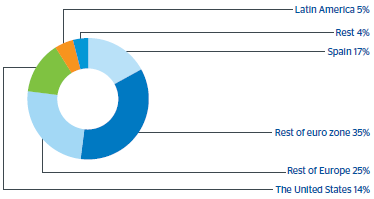The credit risk assessment in OTC financial instruments is made by means of a Monte Carlo simulation, which calculates not only the current exposure of the counterparties, but also their possible future exposure to fluctuations in market variables.
The model combines different credit risk factors to produce distributions of future credit losses and thus allows a calculation of the portfolio effect; in other words, it incorporates the term effect (the exposure of the various transactions presents potential maximum values at different points in time) and the 99 Risk in market areas correlation effect (the relation between exposures, risk factors, etc. are normally different to 1). It also uses credit risk mitigation techniques such as legal netting and collateral agreements.
The maximum credit risk exposure in derivatives to counterparties in the Group as of 31-Dec-2011 stood at €58,494m, an increase of 31% on year-end 2010. The maximum credit risk exposure in derivatives in BBVA, S.A. is estimated at €52.796 million. BBVA S.A.’s overall reduction in terms of exposure due to netting and collateral agreements was €37,587m.
Therefore, the net risk in derivatives at BBVA, S.A., as of December 31, 2011, is €15,210m.
As of December 31, 2011, gross exposure amounts to €54,015m and the portfolio effect in that date is €3,441m.
The table below shows the distribution by maturity of the maximum exposure amounts under OTC financial instruments. Maturity index is 3.14 years.
The counterparty risk assumed in this activity involves entities with a high credit rating (equal to or above A- in 81% of cases). Exposure is mainly concentrated in financial entities (87%) and corporates (6%).
By geographical area, the highest exposure of BBVA, S.A. was in Europe (77%) and the United States (14%), which together account for 91% of the total.



